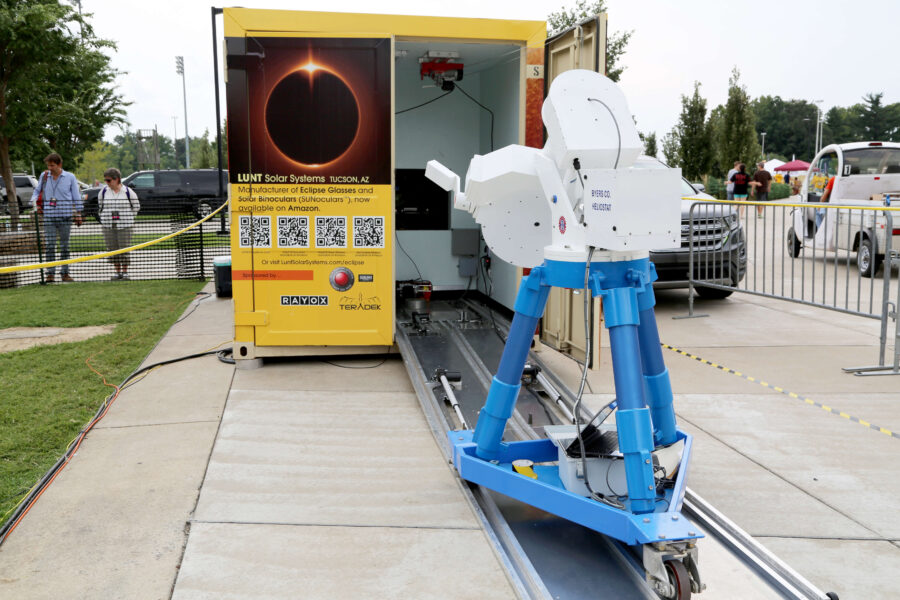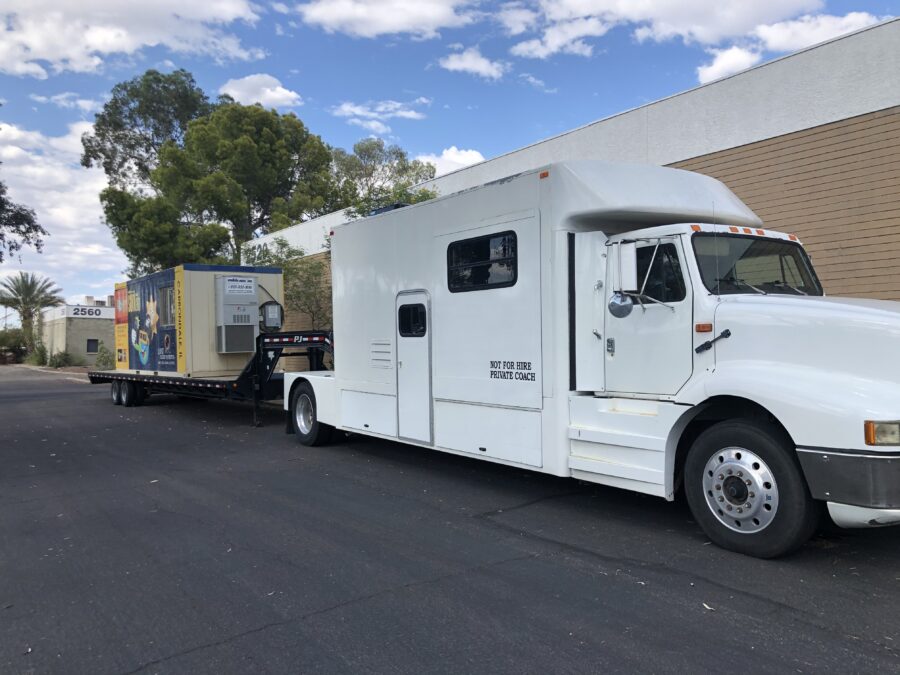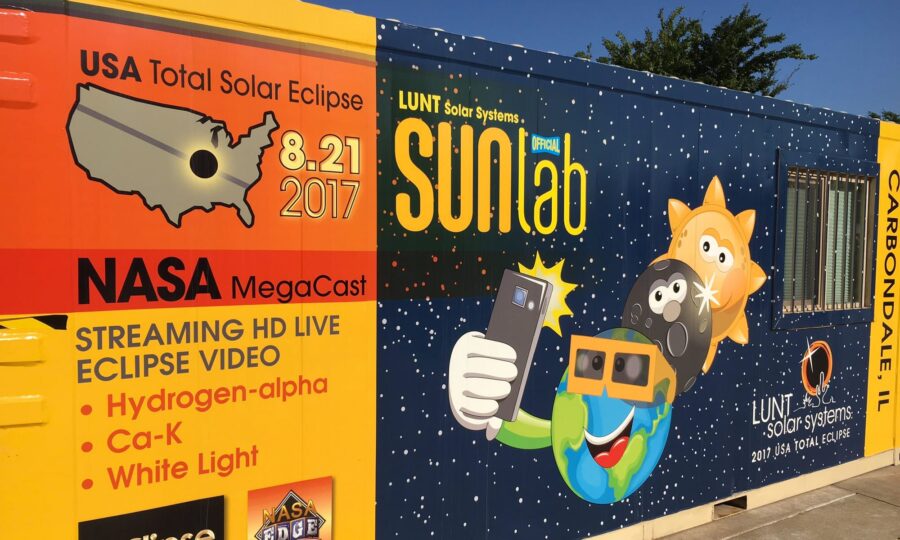Lunt Solar Systems is very excited to announce that we have been subcontracted by NASA and Goddard Space Flight Center to team with NASA Edge for the Live broadcast of the 2024 Total Solar Eclipse from Carbondale, Southern Illinois.
The event is open to the public and will be broadcast locally in the stadium and live via the web. Visit the Official NASA Edge website for more information on when and how you can join in the fun.
Lunt will be providing a Solar Lab that will house a 20” Heliostat feeding Sunlight to three @ 230mm Lunt Solar Telescopes fitted for Hydrogen-alpha, Calcium-k, and White Light. The images will be captured using RED monochrome cameras, processed in real time and broadcast live in 4k.



Check out the Lunt website and make sure you sign up for our Newsletter to stay up to date on the construction of our mobile SUNlab.
Here is a low-resolution image taken through the Lunt 230 Hydrogen-alpha scope in “single stack” mode (currently being tested).

The Lunt SunLab was built by Lunt Solar in 2017 for NASA for the “Great American Eclipse,” a highly-successful project that broadcast the eclipse in many digital formats in 2017 from Carbondale, Illinois.
The SunLab will be rebuilt at Lunt Solar Systems in Tucson and will be a mobile and robotic facility that will capture the daily activity of the Sun in 3 wavelengths of light: White Light, Calcium-k, and Hydrogen-alpha.
The SunLab is mounted on the back of a goose neck trailer and pulled by a Freightliner truck with an added office/facilities area. The trailer is equipped with auto-leveling jacks. The trailer can be maneuvered into position such that it aligns with north for accurate Solar tracking.
At the rear of the trailer there will be a 20″ Byres Heliostat with guided tracking on a fixed pier. This Heliostat is one-of-a-kind and will serve to direct the Sunlight into the SunLab. It will be protected in a custom roll-off observatory to maximize its view of the sky.
Inside the lab the Sun will fill the apertures of three @ 130mm Lunt Solar Telescopes. These telescopes will each be fitted with special filters:
Hydrogen-alpha
Aperture: 130mm
Wavelength: 656.28nm (tuneable +/-1 Angstrom)*
Bandpass: <0.65A (<0.35A optional)*
Calcium-k
Aperture: 130mm
Wavelength: 393.4nm
Bandpass: 2.2 Angstroms (fixed)
White Light
Aperture: 130mm
Wavelength: Full Spectrum
Bandpass: NA
Our H-alpha systems are remotely tuneable for capturing doppler shifting events and fine tuning to desired details. The tuning is instantaneous and can be calibrated to wavelength. There is no waiting on the time it takes to heat or cool and reach equilibrium. Our etalon systems are also barometrically sealed and not affected by changes in atmospheric conditions.
At the rear of the telescopes we will have a computerized XYZ stage that houses our RED 8k Helium Monochrome camera. The camera can be quickly moved between each telescope and brought to auto/manual/remote focus. Eventually we hope to be able to have all 3 RED cameras available at all 3 telescopes to capture all 3 wavelengths simultaneously. However, at the moment we have enough computing power to handle one 8k feed with processing, colorization, and storage, or for broadcast in near real time.
Data Capture. Processing, and Storage Overview:
These specifications are based on the 6k imaging systems that we had in place in 2017. They will be updated to reflect the 8k specification once the software and processing procedures have been developed.
The Sun will be captured daily. Active areas will be captured and stored at the various wavelengths and processed.
Lunt will store any interesting raw data for future use and will process video and stills in various formats for educational, research, social and news media distribution.
It is our plan to offer the raw data and processed media to Astronomy Enthusiasts, Educators, and Researchers at little to no cost.
Because the SunLab will be fully robotic we will allow interested parties to book time on the Lab for their own use.
Data can be stored and either shipped to the user on a drive or made downloadable via a third-party app.
The basic specifications of the feeds are as follows:
1) 3x Live Feeds from 8k RED Monochrome Camera:
- 3x live feeds in Ha, CaK & White Light. (One wavelength only at one time)
- HDSDI progressive @ 29.97FPS
- False color plus basic tone mapping applied to live signal.
2) Time-Lapse files from 8k RED Monochrome Camera:
- Up to 8K (7680×4320, 4096×2160 or 3840×2160) image sequences in H.265 or similar compressed format
- Each image in sequence will be produced by stacking/deconvolution with false color
- Image sample rate between 0.5 – 3.0FPM, playback rate between 20 – 30FPS.
- As data is continually captured, areas of interest can be isolated and processed as time-lapse sequences
3) Still Images from 8k RED Monochrome Camera:
- 6K (6144×3160) images in TIFF & JPEG formats
- Each image will be produced by stacking/deconvolution with false color
- As data is continually captured, areas of interest can be isolated and processed as individual still frames
4) Archived Image Data from 8k Monochrome Camera:
- As RED Mini-Mags are filled, the R3D compressed RAW files are transferred to NAS for retrieval by image processing workstations
- R3D files and processed stills and time-lapse files will be archived with professional cataloging software for easy future retrieval.
The SunLab can be run off main power or from its internal generator. The lab is climate-controlled to maintain the processors and backup PC systems.